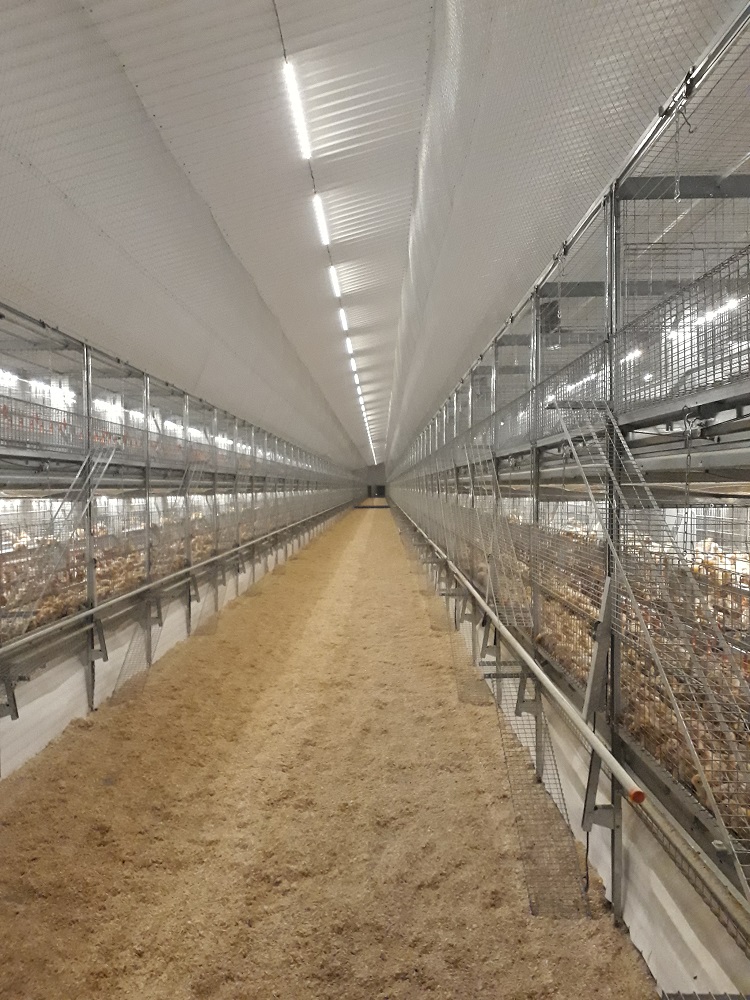Bedfordshire egg producer Bird Bros decided to go the extra mile by rearing its own pullets for its free-range egg business, and recently invested in a new multi-tier rearing unit
Free-range egg production has undergone a remarkable transformation in recent years. In the recent past, flat-deck laying houses were at the cutting edge production whereas now multi-tier units have become commonplace.
An often overlooked part of the egg production cycle is the rearing of the day old chicks to point-of-lay pullets, but quietly in the background, these units have also been having their own small revolution.
“We now see a great deal of interest in new multi-tier rearing units,” says Richard Buchan, sales manager at Big Dutchman’s UK distributor Newquip. “Big Dutchman have long been advocates for rearing pullets in the correct way to ensure good laying performance from the very first egg and anyone now using these aviary rearing systems sees the benefits immediately.
“There are big advantages for the birds to be reared in conditions and equipment that are similar to those used throughout their laying period and a lot of farmers are now looking for their birds to be reared in multi-tier systems,” he says.
One such egg producer is Stuart Bird of Bird Bros in Bedfordshire. After investing in a new farm, he built three new 32,000 bird free range egg laying houses and also decided to rear his own pullets.
“It made a lot of sense,” says Bird. “After investing in the laying houses why would you not go that step further and invest in the correct rearing unit as well? It gives the birds the best possible start and their transition into the multi-tier laying unit is made so easy as the birds know exactly what to do as soon as they are transferred.”
Bird decided on the Big Dutchman Filia rearing system which was installed by Newquip. Compliance with various accreditation bodies was essential and the Filia system ticked all those boxes, he says.
Built in three rows in a clear span 82m x 19m Harlow house, each row has two tiers, each tier incorporating feeders, drinkers, LED lighting and, just like the laying unit, each row includes manure removal belts which Bird runs once a week. Feed is supplied from a Collinson feed silo with weigh cells on the legs which are connected to the house computer which shows what feed is left in the silo, but also the running feed consumption per bird.
The houses are initially heated with LPG heaters along with recirculation fans to ensure a good heat distribution and multi-step ventilation is automatically controlled by Big Dutchman’s Viper climate and production computer.
“I really like the Filia,” says Bird. “We place all the day old chicks on the lowest level and they are held into the system for a few days with the front grills, however the top half of these grills fold down so access to the birds is really easy.”
The chicks adapt to the system quickly and are introduced to the materials and conditions they will encounter once in the laying unit. The birds are then gradually released onto the floor where they start exploring and scratching before returning into the system at night. This movement training is facilitated by the use of the LED system lights.
Inside the Filia, there is also a raised training platform where the birds learn to jump on and off. “In time, using ramps and perches, they soon find their way to the top level and very quickly you start to see the natural up and down movement of the birds which we see every day in the multi-tier laying units,” he adds.
Buchan points out the Filia system incorporates automatically folding perches which assist the birds in accessing the aviary at any time but fold in towards the sides to encourage any perching birds to jump back into the system when lights start to dim for their bedtime.
The litter area underneath each row is fully accessible but can be closed off by of a solid curtain. This curtain prevents the young chicks being distracted by birds on the other side while learning to return into the aviary at night.
Bird says: “I would recommend anyone thinking about rearing their own birds to seriously consider investing in a proper aviary system. The advantages to the birds in rear are many, and you will continue to reap the benefits throughout the laying period.”


